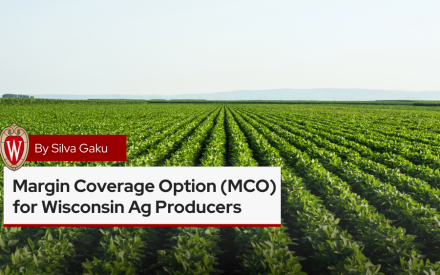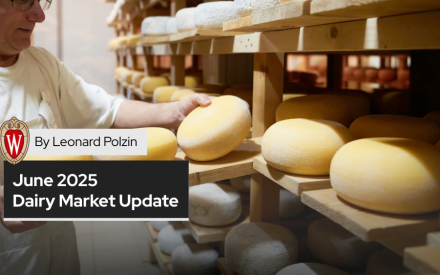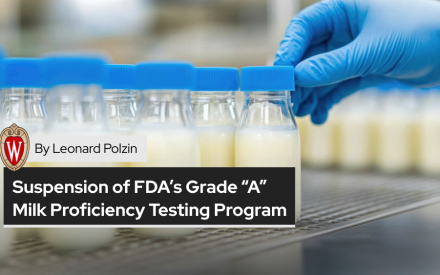As part of the 2018 Farm Bill, each year farmers can make a decision with regard to the commodity support programs ARC (Agriculture Risk Coverage) and PLC (Price Loss Coverage). For the 2021 crop year, sign up is currently ongoing, with the March 15, 2021 deadline rapidly approaching.
– Paul Mitchell, UW Ag & Applied Economics Professor and Extension Specialist
If you have not already visited your local Farm Service Agency (FSA) county office to make your election for either the Agriculture Risk Coverage (ARC) or the Price Loss Coverage (PLC) program and to sign your annual enrollment contract, you should call and make your appointment now.
How ARC and PLC Work
PLC creates a price floor at the national level, triggering payments if the national marketing year average price is less than the reference price for a crop. PLC reference prices are $3.70 for corn, $8.40 for soybeans, $5.50 for wheat, and $2.40 for oats. If a PLC payment is triggered, the payment is the farm’s PLC yield times the price loss times 85% of the farm’s base acres.
ARC-CO (County ARC) creates a revenue guarantee for each crop at the county level based on historical county yields and national prices using a detailed formula. If actual county revenue falls below the guarantee, ARC payments equal the revenue loss times 85% of the farm’s base acres. The ARC-CO revenue guarantee is updated annually for each county. Local FSA offices have the revenue guarantees for each crop in your county.
Crop-Specific Recommendations
Farmers can choose ARC-CO or PLC separately for each FSA farm and crop. For example, one of your farms can use PLC for soybeans and another can use ARC-CO. The crop-specific recommendations below are based on comparing projected prices for the 2021 crop to the PLC reference price and simulations using the ARC/PLC Payment Calculator developed by the University of Illinois (https://fd-tools.ncsa.illinois.edu/). A video on the Resources page further explains the logic for these recommendations based on the historical and projected crop prices and the PLC reference prices. An additional resources page (https://aae.wisc.edu/pdmitchell/extension/arc-plc-signup/) is available for farmers (and those working with farmers) to help them make their decisions. Resources include videos and written materials, as well as links to decision aids.
Based on this information, the following recommendations are suggested for the major crops of corn, soybeans, and small grains:
- Corn: Choose PLC.
- Soybeans: Choose County ARC.
- Wheat, Barley, Grain Sorghum and Sunflowers Choose PLC.
- Oats: Choose County ARC.
Note that these program payments are not guaranteed but depend on the weighted average of national prices for farmers through the entire marketing year. The corn and soybean marketing year does not end until Aug 31, 2022, so these payments, if triggered, would not be paid until Sep/Oct of 2022.
Crop Insurance, SCO, and ARC versus PLC
These programs have some overlap with crop insurance, but I recommend making program decisions separate from crop insurance decisions, as they use different acreages, prices and yields. Crop insurance uses actual planted acres and includes prevented plant coverage, while these programs make payments using base acres. Crop insurance uses current expected market prices, while these programs use average historical prices or pre-set refence prices that can be well above or well below actual crop values. Lastly, these programs use fixed PLC yields or county yields, while crop insurance uses actual farm yields. Thus, I recommend making farm program decisions separate from crop insurance decisions. The only exception is if a farmer plans to buy SCO (Supplemental Coverage Option) as part of their crop insurance coverage, which means they must choose PLC for the insured crop.
SCO is an add-on to crop insurance that covers part of the “deducible”. For example, if a farmer buys Revenue Protection (RP) with a 75% coverage level, the farmer pays the first 25% of losses below their expected revenue as a deductible. SCO allows a farm to cover part of this deductible using a county policy, with coverage up to 86% of expected revenue. Farmers already buying RP with an 85% coverage level may find adding SCO offers similar coverage at lower cost if they reduce their RP coverage level. However, few Wisconsin farmers use 85% coverage for their RP policy – only 5%-6% of all insured corn and soybean acres in the state in 2019. In terms of crop-specific recommendations, the few corn and soybean farmers who buy RP with an 85% coverage level may want also choose PLC for their soybeans (not just their corn) and then consider buying SCO and reducing their RP coverage level slightly. I generally do not recommend buying RP with an 85% coverage level, as most Wisconsin farmers find RP with a 70% to 80% coverage level the most cost-effective option. However, interested farmers should discuss SCO with their crop insurance agent.
Farms that May Find ARC-IC Preferable
ARC-IC received more attention last signup – nationally about 6% of corn and soybean base acres choosing it. ARC-IC uses actual farm yields and planted acres to create a revenue guarantee for all crops with base acres on a farm. Farmers can use ARC-IC on some of their FSA farms and ARC-CO or PLC on other farms. The Resources web page includes videos and an article on ARC-IC, explaining how it works and the types of farms that may find it preferable. In brief, FSA farms with small number of base acres and highly variable yields may find ARC-IC useful, as may FSA farms with high yields well above the ARC-CO county yield, such as irrigated farms in counties that FSA does not offer an irrigated option. Lastly, farms with more than 15% of their acres planted in vegetables can potentially receive larger payments with ARC-IC, since it allows more non-payment acres. See the Resources web page for more information.
If you have not already visited your local Farm Service Agency (FSA) county office to make your election for either the Agriculture Risk Coverage (ARC) or the Price Loss Coverage (PLC) program and to sign your annual enrollment contract, you should call and make your appointment now.
ARC and PLC provide financial protections to farmers from substantial drops in crop prices or revenues and are vital economic safety nets for most American farms. These programs cover 20 commodities produced in the U.S.
If you fail to enroll by the deadline, you are ineligible to receive payment for 2019 ARC/PLC. Beat the rush and call your local FSA office today to schedule an appointment


 Margin Coverage Option (MCO) for Wisconsin Ag Producers
Margin Coverage Option (MCO) for Wisconsin Ag Producers Dairy Market Dynamics and Domestic Constraints: A Dairy Sector Assessment as of June 2025
Dairy Market Dynamics and Domestic Constraints: A Dairy Sector Assessment as of June 2025 U.S.–Canada Dairy Trade Relationship (2025–Present)
U.S.–Canada Dairy Trade Relationship (2025–Present) Suspension of FDA’s Grade “A” Milk Proficiency Testing Program – A Comprehensive Analysis
Suspension of FDA’s Grade “A” Milk Proficiency Testing Program – A Comprehensive Analysis


